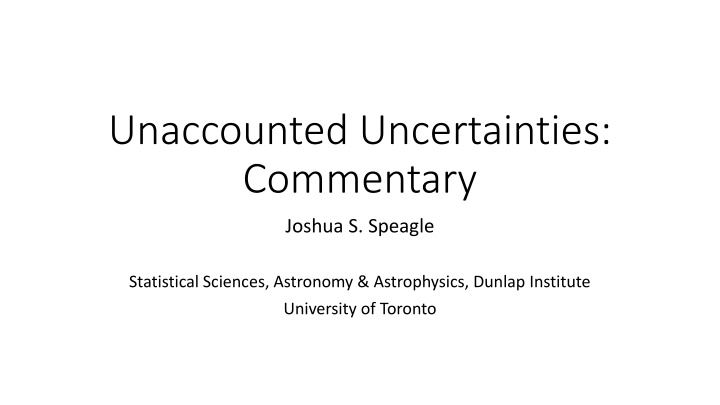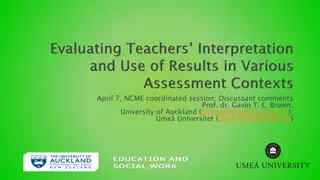
Unaccounted Uncertainties and Systematics in Data Modeling
Explore challenges in data modeling related to unaccounted uncertainties and systematics, including strategies for uncovering deficiencies, the role of Bayesian vs. Frequentist approaches, handling outliers, managing prior influence, and transitioning from point estimates to samples.
Download Presentation

Please find below an Image/Link to download the presentation.
The content on the website is provided AS IS for your information and personal use only. It may not be sold, licensed, or shared on other websites without obtaining consent from the author. If you encounter any issues during the download, it is possible that the publisher has removed the file from their server.
You are allowed to download the files provided on this website for personal or commercial use, subject to the condition that they are used lawfully. All files are the property of their respective owners.
The content on the website is provided AS IS for your information and personal use only. It may not be sold, licensed, or shared on other websites without obtaining consent from the author.
E N D
Presentation Transcript
Unaccounted Uncertainties: Commentary Joshua S. Speagle Statistical Sciences, Astronomy & Astrophysics, Dunlap Institute University of Toronto
A Complementary Perspective Often conceptual/practical problems when trying to combine datasets or properly model sources come down to unaccounted systematics. Properly modeling and propagating these to other downstream tasks is becoming an ever-larger challenge. Example: Spectral + photometry modeling Na ve ?spec + ?phot But if we believe our data this is exactly what we want! Skepticism arises because most approaches ignores different systematics present in spectral data and photometry, which make ?spec,eff ?spec. 2 2 often discounted because ?spec ?phot.
Uncovering Systematics What tools have you found that are very useful in discovering deficiencies (unknown systematics) present in the modeling? Examples: quantile-quantile plots, posterior predictive plots, p-value checks, simulation tests, etc.
Role of Bayesian vs Frequentist Approaches Both approaches presented rely on priors and marginalization over nuisance parameters. Is moving in this direction the path forward, or are there frequentist methods that can be useful?
Outliers How can we find a balance between ignoring (some) outliers and/or using them to drive our systematics modeling?
Prior Influence on Systematics Models How much influence can/should the prior have over the final outcome? What guidance should there be in setting this? How can we look into quantifying this? How can we diagnose and/or account for mismatches between priors and data (likelihood)?
Point Estimate Samples What are some of the challenges moving from single point estimates to samples? Statistical (modeling, degeneracies, convergence, effective sample size, etc.) Computational (additional compute time, redoing pipelines, etc.) Science (data sharing, downstream error propagation, interpretation, etc.) How will these procedures work without access to analytic underlying models (and associated gradients)?
Role of Machine Learning How will machine learning techniques help us approach some of these problems, both within and outside of traditional statistical modeling frameworks?










